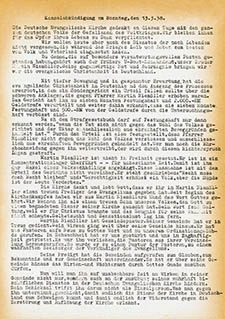The Niemöller Affair
In the summer of 1937, the Confessing Church fell victim to a large-scale wave of arrests by the Gestapo. Martin Niemöller, the Confessing Church’s quintessential iconic figure, was also arrested on July 1, 1937. He was accused of having denigrated government actions and leading Nazi politicians, called for the contravention of state laws and published writings that disturbed public peace.
The Council of Brethren of Evangelical Church of the Old Prussian Union protested in a pulpit announcement of July 2, 1937 that Niemöller had been concerned about the glory of God in our nation and obedience to God’s word. Where this is at stake, the Christian’s conscience is bound. Niemöller’s arrest affected all of Protestant Christendom in Germany. With him, the church of the Gospel in Germany had been summoned before the courts. The Gestapo made more arrests to identify the author of the pulpit announcement.
Niemöller’s trial was not held until February of 1938 because the Nazi state wanted to obtain a sure conviction. The intercessory prayer services authorized for Niemöller by the Confessing Church were forbidden. His sentence of a light prison term and a fine was tantamount to an acquittal. He had already served the prison sentence through the time spent in detention while awaiting trial. Rather than being released however, Niemöller was taken away to internment in a concentration camp as “Hitler’s personal prisoner”.
The Provisional Church Government protested against this injustice with a pulpit announcement and charged that Niemöller had been taken away so that the voice of the church in Germany is finally silenced and so that the resistance against the destruction and dissolution of the church finally wanes.
The Confessing Church held intercessory prayer services for Niemöller and circulated thousands of postcards with Niemöller’s picture and sayings. The protests did not help though: Niemöller did not leave concentration camp internment until 1945.
Source / title
- © Ev. Arbeitsgemeinschaft für Kirchliche Zeitgeschichte München, C 3. 23


